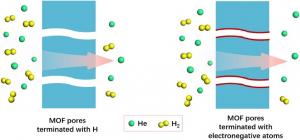Unlocking membrane-based He/H2 separation with AI
USA, April 9, 2024 /EINPresswire.com/ -- Researchers found that the electronegative atoms on the pore surfaces can enhance the gas separation by a combination of machine learning and multiscale simulation. This approach not only provides valuable theoretical guidelines but also accelerates the development of novel MOF membranes aimed at efficient separation of He/H2.
Technological advancement and data proliferation have deemed artificial intelligence (AI)-driven innovation as growth opportunity to the development of breakthrough materials for special applications, especially in the field of gas separation. One of the main challenges associated with this process is the extremely close kinetic diameters of the two gas molecules, resulting in low membrane selectivity.
In a study (https://doi.org/10.1016/j.gce.2024.01.005) published in the KeAi Green Chemical Engineering, a group of researchers from China came up with a novel approach to explore materials with enhanced helium extraction efficiency—with the aid of AI. In particular, the researchers investigated structure-performance relationships, elucidated separation mechanisms and identified crucial factors influencing the separation performance to design metal-organic framework (MOF)-based membranes. The pore limiting diameter (PLD) and void fraction (φ) were revealed as the most important physical features for determining the membrane selectivity and He permeability, respectively.
“Traditional material development faces constraints, but AI is revolutionizing the field,” says Zhengqing Zhang, lead investigator of the study “Our approach not only reveals hidden mechanisms but also uncovers new insights."
The team hopes that their results would encourage scientists to continue investigating the intersection of AI and material science, opening doors to unprecedented technological advancements.
DOI
10.1016/j.gce.2024.01.005
Original Source URL
https://doi.org/10.1016/j.gce.2024.01.005
Funding information
This work is supported by National Natural Science Foundation of China (No. 22141001 and 22108202)
Lucy Wang
BioDesign Research
email us here
Legal Disclaimer:
EIN Presswire provides this news content "as is" without warranty of any kind. We do not accept any responsibility or liability for the accuracy, content, images, videos, licenses, completeness, legality, or reliability of the information contained in this article. If you have any complaints or copyright issues related to this article, kindly contact the author above.

